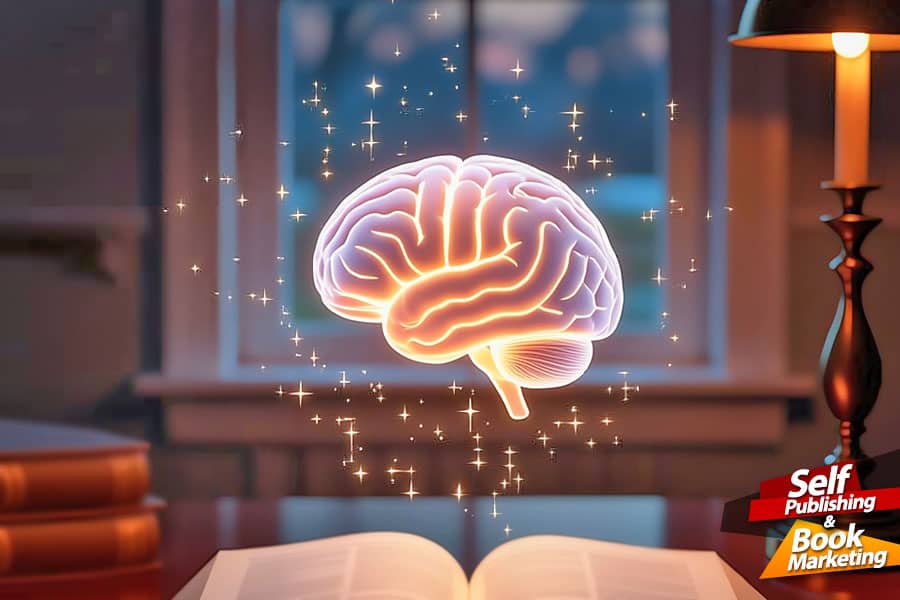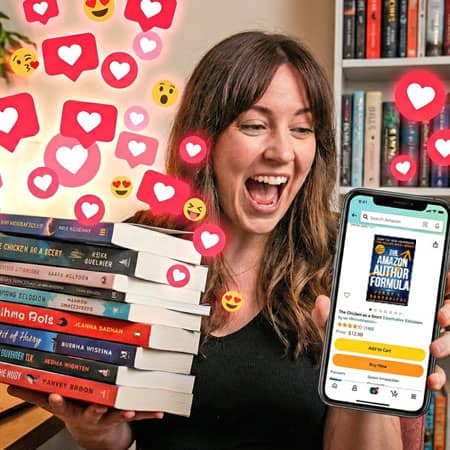
Jennifer Crosswhite - October 20, 2025 - 
Unputdownable Book: The Brain Science Behind Stories That Hook Readers!
Unputdownable book hooks the reader from the first page—but what makes a story truly impossible to put down?Here’s a secret most writers don’t know: Your reader’s brain doesn’t care if you’re writing fiction or nonfiction. It craves the same pattern either way.
Our brains are survival machines. Every second of every day, they’re scanning for information about how to survive and thrive. And they’re specifically wired to extract this information from stories.
Think about it. How does every culture pass down vital wisdom? Stories. Aesop’s fables. Biblical parables. Business case studies. These aren’t just entertainment or information—they’re survival manuals disguised as narratives. They teach us how to navigate danger, succeed in life, and transform ourselves, all wrapped in a format our brains can’t resist remembering, exactly what makes an unputdownable book.
The Blueprint Your Brain Craves
Here’s where it gets interesting: When you read any story—real or imagined—your brain automatically casts itself as the protagonist. Read about someone escaping danger? Your brain files that away under “potentially useful.” Read about someone building a successful business? Same filing system.
Stories work because they follow a pattern our brains instinctively recognize. Understanding this pattern makes you incredibly powerful as a writer, whether you’re crafting fiction or nonfiction—and it’s exactly what can turn your story into an unputdownable book. (Learn more about narrative psychology.)
Start with the Wound
Every compelling story starts with a character who has a wound—some past trauma that created a lie they believe about themselves. In fiction, it might be Luke Skywalker believing he’ll never amount to anything. In nonfiction? It’s your reader.
For fiction writers: Your protagonist needs this wound. They’ve built their entire life around protecting it.
For nonfiction writers: Your reader is the protagonist. What’s their wound? What lie do they believe? A business book reader might think “I’m not cut out to be an entrepreneur.” A parenting book reader might believe “Good parents never lose their temper.” Name this wound explicitly in your introduction. Make them feel seen.
Create the Inciting Incident
Something must shatter the carefully constructed world.
In fiction: An event forces your character out of their comfort zone. For Luke, it’s a droid arriving with Princess Leia’s message.
In nonfiction: Your book itself is often the inciting incident. Why did they pick it up now? What’s at stake if they don’t change? Create urgency. Paint the picture of what happens if they keep protecting their wound, then show what’s possible if they heal it.
The Real Goal Versus the Surface Goal
Every story has two goals:
- The external goal (rescue the princess, lose weight, build a business)
- The internal need (heal the wound, transform the lie into truth)
Being human, we try everything to get what we want while still protecting our wounds. But great stories—fiction or nonfiction—won’t let us.
Build Progressive Challenges
Fiction: Throw conflict after conflict at your character. Each challenge forces them closer to confronting their wound, usually making things spectacularly worse. Asteroid fields, Imperial captures, mentor deaths—each one pushes Luke to confront his belief that he’s worthless.
Nonfiction: Structure your chapters as escalating challenges. Start with easier mindset shifts and simpler actions. Build to harder truths and bigger challenges. If you’re writing about productivity, don’t jump straight to “redesign your entire life.” Start with “notice where your time actually goes.” Build their strength gradually.
Use case studies as mini stories within this larger arc. Show Sarah trying to launch her business while still believing she’s not good enough. Show her early failures. Then show her breakthrough when she confronts the lie.
The Dark Moment
Every transformation requires a black moment when the wound is ripped wide open and the lie feels truer than ever.
Fiction: All is lost. Luke faces the Death Star, seemingly powerless to save anyone.
Nonfiction: Acknowledge that your reader will hit this wall. “There will come a point, usually around week three, when you’ll think this isn’t working. When every voice in your head will scream that you’re the exception, that you really can’t change.” Name it. Normalize it. Give them tools to push through.
The Epiphany and Transformation
In the darkness, something shifts. The lie reveals itself as a lie.
Fiction: “Use the Force, Luke.” In trusting something beyond himself, Luke shatters his limiting belief and destroys the Death Star—not through luck, but through believing in his capability.
Nonfiction: Build to a crystallizing moment of understanding. One business book does this by having readers write their obituary from two perspectives: continuing with their current lie versus embracing their capability. The contrast creates the epiphany.
Resolution Through Action
The character must demonstrate their change. They do what they couldn’t do on page one.
Fiction: Your protagonist uses their new understanding to achieve their goal.
Nonfiction: Give your reader a clear way to immediately apply their transformation. This isn’t just an action step—it’s proof they’ve changed. They couldn’t have done this at the beginning because they still believed the lie.
Story Beats: Fiction and Nonfiction Examples That Make an Unputdownable Book
#1. Opening Hooks
Fiction: “ The morning Sarah discovered the note on her door, she was wearing mismatched socks and humming off-key.”
• Creates immediate sympathy
• Establishes normalcy before disruption
• Plants the wound (betrayal/trust issues)
Nonfiction: “ You’ve checked your email seventeen times in the last hour, even though nothing urgent is happening. Sound familiar?”
• Makes reader feel seen
• Names the behavior they’re ashamed of
• Identifies the wound (lack of focus/control)
Parallel Purpose: Both immediately connect to an emotional truth and signal that change is coming.
#2. Character/Reader Wounds
Fiction Examples:
Pride and Prejudice: Elizabeth believes first impressions are always accurate (wound: her need to be the smartest person in the room)
The Great Gatsby: Gatsby believes he can recreate the past (wound: his inability to accept reality)
Harry Potter: Harry believes he must face everything alone (wound: abandonment by those meant to protect him)
Nonfiction Equivalents:
Business Book: “ You believe successful people are fundamentally different from you” (wound: imposter syndrome)
Parenting Book: “ You think asking for help means you’re failing as a parent” (wound: perfectionism)
Health Book: “ You’ve decided your body is broken and betrays you” (wound: disconnection from self)
Parallel Purpose: Both establish the lie that must be confronted for transformation to occur.
#3. Progressive Complications
Fiction – Romance Novel:
• Chapter 3: Misunderstanding at coffee shop (testing trust)
• Chapter 7: Ex returns to town (testing commitment)
• Chapter 12: Job offer in another city (testing priorities)
• Chapter 18: Family disapproves (testing independence)
Nonfiction – Business Book:
• Chapter 3: Identifying your first customer (testing courage)
• Chapter 7: Your first rejection (testing resilience)
• Chapter 12: Scaling beyond yourself (testing delegation)
• Chapter 18: Competitor copies you (testing confidence)
Parallel Purpose: Each challenge forces confrontation with a deeper layer of the wound.
#4. The False Victory
Fiction: Elizabeth Bennet rejects Darcy’s first proposal, feeling vindicated in her judgment of him. She thinks she’s won by protecting herself from an arrogant man.
Nonfiction: “ You’ll lose five pounds in the first week and think you’ve found the answer. This isn’t the victory—it’s the setup for your real test.”
Parallel Purpose: Both show the protagonist/reader using their old pattern successfully, right before it stops working.
#5. Supporting Cast/Case Studies
Fiction – Mystery Novel:
• Best friend represents who detective used to be
• Suspect represents who detective could become if they don’t heal
• Victim represents the cost of the detective’s wound
Nonfiction – Leadership Book:
• Case Study 1: Mae who tried to change too fast (cautionary tale)
• Case Study 2: Marcus who resisted the process (reader’s current state)
• Case Study 3: Priya who had the breakthrough (possibility model)
Parallel Purpose: Each secondary element mirrors or illuminates aspects of the main transformation.
#6. The Mentor’s Wisdom
Fiction – Star Wars: “ Do or do not. There is no try.” (Yoda addressing Luke’s self-doubt)
Nonfiction – Creativity Book: “ You’re not blocked because you lack ideas. You’re blocked because you’re afraid your ideas aren’t good enough.” (Author addressing reader’s perfectionism)
Parallel Purpose: Both deliver the truth the protagonist/reader isn’t ready to hear yet but will understand later.
#7. The Dark Night/Rock Bottom
Fiction – Flash Point: Sarah realizes that she can either confront her fear of fire and rescue her boyfriend or let fear continue to run her life and lose everything that has meaning to her.
Nonfiction – Career Book: “ This is the moment when you’ll sit in your car in the parking lot, unable to walk into the building one more time. This is not weakness. This is your awakening beginning.”
Parallel Purpose: Both strip away all the coping mechanisms, forcing raw confrontation with the truth.
#8. The Callback/Full Circle Moment
Fiction: Harry Potter uses the same spell (Expelliarmus) in his final battle with Voldemort that he learned in his second year—but now he understands why it’s his signature (choosing disarmament over destruction).
Nonfiction: “ Remember that email checking we talked about in chapter 1? Notice how you haven’t thought about your inbox once while doing this exercise. That’s not discipline. That’s transformation.”
Parallel Purpose: Both demonstrate change by revisiting the beginning with new understanding.
#9. Subplots/Subtopics as Mirrors
Fiction – Women’s Fiction:
• Main plot: Saving her marriage
• Subplot 1: Daughter’s college crisis (mirrors letting go)
• Subplot 2: Mother’s illness (mirrors accepting help)
• Subplot 3: Business partnership (mirrors trust)
Nonfiction – Time Management:
• Main topic: Productivity systems
• Subtopic 1: Energy management (mirrors the wound of burnout)
• Subtopic 2: Boundary setting (mirrors the wound of people-pleasing)
• Subtopic 3: Deep work (mirrors the wound of distraction addiction)
Parallel Purpose: Each thread reinforces the main transformation from different angles.
#10. The Evidence of Change
Fiction: Elizabeth Bennet defends Darcy to Lady Catherine—something unimaginable in chapter 1 when she delighted in mocking him.
Nonfiction: “ Write your first blog post now. Not next week. Now. The fact that you’re not opening seven tabs to research best blogging practices is your proof of transformation.”
Parallel Purpose: Both show the character/reader doing naturally what once required enormous effort or felt impossible.
#11. Secondary Character Transformations
Fiction: While Ebenezer Scrooge transforms, we also see Tiny Tim get healthier, Bob Cratchit become empowered, and Fred gain his uncle back.
Nonfiction: “ When you change your leadership style, watch what happens: Your team starts taking initiative. Your kids become more independent. Your partner relaxes. Your transformation creates ripples.”
Parallel Purpose: Both show that individual change affects the entire system.
#12. The Cost of Not Changing
Fiction: Show a character who refuses the journey—Gatsby’s Tom Buchanan, who ends the story exactly as he began, wealthy but emotionally bankrupt.
Nonfiction: “ I met Richard five years ago at the same conference. He’s still talking about the same book he’s going to write ‘someday.’ Don’t be Richard.”
Parallel Purpose: Both illustrate the tragedy of protecting the wound instead of healing it.
Key Insight for Writers: Building an Unputdownable Book
Notice how every fiction technique has a direct nonfiction application? That’s because the brain processes both the same way. Whether your reader is following Elizabeth Bennet’s journey or their own journey through your business book, their brain is asking the same questions:
• “ What wound is being protected?”
• “ What lie needs confronting?”
• “ What will it cost to change?”
• “ What will it cost not to?”
• “ How do I navigate this transformation?”
The only difference is that fiction readers experience it vicariously through characters, while nonfiction readers experience it directly as themselves. But the journey—and the brain’s hunger for it—remains exactly the same.
The Secret Weapon: Your Own Story
The most powerful books—fiction or nonfiction—include the author’s journey with the same wound. In fiction, authors often process their own wounds through their characters, which is often what makes a story evolve into an unputdownable book. In nonfiction, share your black moment and epiphany directly. You’re not the guru on the mountain; you’re the guide who’s walked this path.
The Nonnegotiable Rules of an Unputdownable Book
#1. Every element must matter. The brain assumes if you included it, it’s relevant to survival. Random details are betrayals.
#2. Everything connects to the wound. That’s the problem the brain is trying to solve. Anything else is noise.
#3. Everything must resolve logically. The brain needs to be able to replicate the solution in real life.
The Ultimate Unputdownable Book Test
Ask yourself: Can someone describe your book as a journey? Can they articulate where the protagonist (or reader) starts emotionally and where they end up?
Neuroscientists have even mapped this effect. In a 2021 study, Functional Brain Connectivity During Narrative Processing Relates to Transportation and Story Influence, researchers discovered that when we’re truly absorbed in a story, our brains mirror the story’s rhythm and emotion—explaining why an unputdownable book feels so alive.
If your fiction is just events without transformation, you’re writing a chronicle, not a story. If your nonfiction is just information without transformation, you’re writing a manual, not an unputdownable book anyone will remember. When was the last time anyone enjoyed reading a manual, or was transformed by it?
Your reader’s brain doesn’t care if you’re teaching accounting or telling tales of dragons—it wants to go on a journey from wounded to healed, from believing the lie to knowing the truth.
Give it that journey, and your book can become an unputdownable book.
If you liked this article you might also like:
• Book Cover Design Trends for 2024
• Book Cover Design Mistakes – Lessons from a Veteran Designer
• Book Cover Redesign Study Case – “How a Monster is Made”
• 3 Tips for Writing a Successful Amazon Book Description
• Amazon Author Central – How to Setup Your Author Page on Amazon!
• The Levels of Writing and Editing Explained Once and for All
• Why First-Time Authors Need an Editor!
• Book Marketers Secrets – 7 Secrets of Top Book Marketers!
• Self-Publishing Success Stories. Secrets of Million Dollar Self-Publishers!
• Never Judge a Book By Its Cover! – Are You Really Sure?
• Business Plan for Authors. Do Authors Need a Business Plan?


